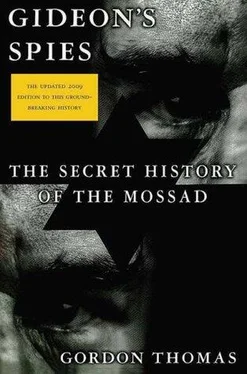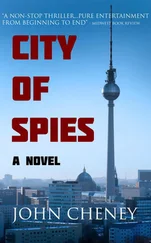Gordon Thomas - Gideon's Spies
Здесь есть возможность читать онлайн «Gordon Thomas - Gideon's Spies» весь текст электронной книги совершенно бесплатно (целиком полную версию без сокращений). В некоторых случаях можно слушать аудио, скачать через торрент в формате fb2 и присутствует краткое содержание. Город: New York, Год выпуска: 2009, ISBN: 2009, Издательство: Thomas Dunne Books, Жанр: История, на английском языке. Описание произведения, (предисловие) а так же отзывы посетителей доступны на портале библиотеки ЛибКат.
- Название:Gideon's Spies
- Автор:
- Издательство:Thomas Dunne Books
- Жанр:
- Год:2009
- Город:New York
- ISBN:978-0-312-53901-6
- Рейтинг книги:4 / 5. Голосов: 1
-
Избранное:Добавить в избранное
- Отзывы:
-
Ваша оценка:
- 80
- 1
- 2
- 3
- 4
- 5
Gideon's Spies: краткое содержание, описание и аннотация
Предлагаем к чтению аннотацию, описание, краткое содержание или предисловие (зависит от того, что написал сам автор книги «Gideon's Spies»). Если вы не нашли необходимую информацию о книге — напишите в комментариях, мы постараемся отыскать её.
Gideon’s Spies
Gideon's Spies — читать онлайн бесплатно полную книгу (весь текст) целиком
Ниже представлен текст книги, разбитый по страницам. Система сохранения места последней прочитанной страницы, позволяет с удобством читать онлайн бесплатно книгу «Gideon's Spies», без необходимости каждый раз заново искать на чём Вы остановились. Поставьте закладку, и сможете в любой момент перейти на страницу, на которой закончили чтение.
Интервал:
Закладка:
Every morning, in his precise tones, Meir Dagan updated those around the table on the hunt for both the soldiers and Nasrallah. For ninety minutes the daily briefing on the next steps to be taken ranged from providing targets for the advance into south Lebanon by the IDF’s six brigades to identifying renewed air strikes to be made on the Beirut suburbs. Then came what Meir Dagan has called “the wider picture.” Would Syria once more increase Hezbollah’s rocket arsenal? Fifteen hundred had been fired so far, another fifteen hundred destroyed. That left ten thousand. What would be the next step that Syria’s president, Bashar al-Assad, could take? His palace at Ladekye, outside Damascus, had already been buzzed by Israeli warplanes. It was Dagan’s idea. He called it “a little warning.” And Iran—what would President Ahmadinejad do? The wiry, gaunt-faced, heavily bearded president had once more said, “We will wipe Israel from the face of the earth.” An idle boast or a serious threat? Meir Dagan’s answers to those troubling questions would remain—at least for the moment—inside the war room. By 8:00 A.M. the men around the table had left to carry out their daily orders. The first the world would learn about them would be on the news bulletins.
Two thousand miles to the west of the Kirya war room, the analysts in Britain’s Joint Terrorism Analysis Centre (JTAC), continued to explore the latest ramifications of Operation Overt, the multi-national terrorist operation. Their suspicions had hardened when the FBI sent MI5 an urgent bulletin—copied to all the other intelligence services engaged in the operation—that suicide bombers had been recruited to hijack transatlantic aircraft by smuggling individual explosive ingredients past airport security and then assembling them as bombs on board. The FBI warning (a copy of which the author has seen) was entitled: “Possible Hijacking Tactic for Using Aircraft as Weapons.” In part it read: “Components of improvised explosive devices can be smuggled onto an aircraft, concealed in either clothing or personal carry-on items such as shampoo and medicine bottles, and assembled on board. To avoid cases of suspicious passenger activity, this will most likely take place in an aircraft’s lavatory.”
Another piece of information had come from an al-Qaeda Web site believed to be operating out of Yemen. Though protected by a secret password, it had been interdicted by GCHQ specialists and had yielded valuable clues. It gave detailed instructions on how to create new types of miniature bombs by using the flash mechanism on a digital camera as an electronic detonator. Various ways of powering the detonator were suggested, including personal music players. What focused the attention of the analysts was that the instructions were written in English as well as Arabic. This raised the strong possibility that the planned attack would require the services of the two cells under surveillance by Operation Overt.
Then, a few days later, a third GCHQ intercept came from another al-Qaeda Web site, this one in Uzbekistan. It discussed the qualities of using an explosive it called “The Mother of Satan” and indicated it had been tried out by Hezbollah. Mossad’s London station chief confirmed the explosive was made from triacetone triperoxide (TATP) and was made from combining four ingredients: two harmless domestic liquids, hair bleach, and nail varnish remover. The Web site promised that “when care is taken to mix the ingredients, the result will be a powerful explosion similar to that produced by a military grenade.” TATP had been the choice of explosive used by suicide bombers in the July 7, 2005, attacks on London. TATP could be carried on board in containers such as bottles of soft drinks or even a feeding bottle for a baby. The two chemicals to create TATP would normally have to be mixed at low temperatures to make the explosive more stable. But for a suicide bomber this would not be necessary. The only problem the terrorists would face would be to ensure the mixture was sufficiently solid before it became a lethal explosive, otherwise it would be difficult to detonate as shown by the failure of the second London suicide attacks on July 21, 2005.
But there was still no timeframe for the attack Operation Overt was monitoring, only that it would most likely originate with flights taking off from Heathrow, London, heading for the United States. As July drew to a bloody close in south Lebanon and Israel, Eliza Manningham-Buller reminded the hunters that “we will not stop them all—but we will have a damned good try.”
By the first week of August 2006, the war had become a grim parade of military funerals and television interviews with grieving families. With each death the unease within Israel deepened over the conduct of the fighting. Retired military experts—known as “the armchair brigade” among Ehud Olmert’s aides—called for an increase in ground forces and bombing raids on Hezbollah’s rocket launchers and for the razing of villages where Hezbollah was suspected of hiding. This had already led to tragedy roundly condemned around the world when Israeli bombs destroyed an apartment block in the south Lebanon city of Cana, killing some fifty women and children. Journalists had reminded readers that Cana was where Jesus had changed water into wine “and now the water of Cana is red with the blood of the innocent,” wrote one reporter. And for the first time since hostilities started, Mossad came under criticism. Why hadn’t its agents located the bunkers and tunnels which, over the past six years, Hezbollah had been using to stockpile rockets supplied by Syria and Iran? The question had led to angry discussions in the Knesset. But there was no response from Meir Dagan. It had been left to Shabtai Shavit to defend his old service, pointing out that the public perception of intelligence gathering does not take into account the “bigger picture below the surface.”
An example of this came on August 3, 2006, when Dagan received a message from an agent in Balbeck, the historic city in the Beka’a Valley that Hezbollah had turned into a stronghold. The message said that Hassan Nasrallah, the head of Hezbollah, would be traveling overnight to meet with Saad bin Laden, the eldest son of Osama bin Laden and his appointed successor. Days before another Mossad agent in Damascus had reported that the scion of the al-Qaeda leader was in the city and had held meetings with Syrian intelligence officers. That night Israeli Black Hawk helicopters swept IDF commandos ninety miles into Lebanon. With them were several Arab-speaking Mossad officers. While the commandos hunted for their human targets, the officers headed for the Hezbollah-operated hospital in the center of Balbeck. They found it deserted; patients, doctors, and nurses had all fled. Using a floor plan provided by a Mossad informer, the team found what they had come for: computers. One was in the medical records office. Another in a consultant’s suite. A third in a nurse’s station. The computers were unplugged and rushed to a waiting helicopter. Two hours later the disks were being studied in Mossad’s Tel Aviv headquarters.
Some information on the disks set out details of Hezbollah “sleeper cells” in Britain. By the time the commandos returned to their base to report they had not found Nasrallah or Saad bin Laden, details of the cells had been transmitted to London. They found their place on the Anacapa wall charts inside the Joint Terrorism Analysis Center.
U.S. Secretary of State Condoleezza Rice was once more back in Tel Aviv, flying in on Air Force One. The Boeing 747-200B was not a particular aircraft, but the call sign for any of the small fleet of aircraft reserved for the president or his senior aides. In all there were seven in the fleet. The aircraft Dr. Rice was using comprised a crew of twenty-six to pilot and look after her needs and seventeen secret agents to protect her on the ground.
Читать дальшеИнтервал:
Закладка:
Похожие книги на «Gideon's Spies»
Представляем Вашему вниманию похожие книги на «Gideon's Spies» списком для выбора. Мы отобрали схожую по названию и смыслу литературу в надежде предоставить читателям больше вариантов отыскать новые, интересные, ещё непрочитанные произведения.
Обсуждение, отзывы о книге «Gideon's Spies» и просто собственные мнения читателей. Оставьте ваши комментарии, напишите, что Вы думаете о произведении, его смысле или главных героях. Укажите что конкретно понравилось, а что нет, и почему Вы так считаете.












